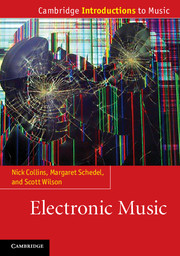Book contents
- Frontmatter
- Contents
- List of illustrations
- List of Tables
- Acknowledgments
- Chapter 1 Introduction
- Chapter 2 Recording technologies and music
- Chapter 3 New sounds and new instruments: Electronic music up until 1948
- Chapter 4 The post-war sonic boom
- Chapter 5 From analog to digital
- Chapter 6 Into the mainstream
- Chapter 7 Synth pop
- Chapter 8 Electronic dance music
- Chapter 9 Continuing the classical?
- Chapter 10 Experimental electronica
- Chapter 11 Sound art
- Chapter 12 Further connections
- Chapter 13 Live electronic music
- Chapter 14 Conclusions
- Notes
- Index
- References
Chapter 8 - Electronic dance music
Published online by Cambridge University Press: 05 May 2013
- Frontmatter
- Contents
- List of illustrations
- List of Tables
- Acknowledgments
- Chapter 1 Introduction
- Chapter 2 Recording technologies and music
- Chapter 3 New sounds and new instruments: Electronic music up until 1948
- Chapter 4 The post-war sonic boom
- Chapter 5 From analog to digital
- Chapter 6 Into the mainstream
- Chapter 7 Synth pop
- Chapter 8 Electronic dance music
- Chapter 9 Continuing the classical?
- Chapter 10 Experimental electronica
- Chapter 11 Sound art
- Chapter 12 Further connections
- Chapter 13 Live electronic music
- Chapter 14 Conclusions
- Notes
- Index
- References
Summary
Movement and music are inextricably combined; in pre-historic origins and even surviving in some African languages today, the word for music has overlapped with the word for dance. Dance crazes have been a prominent feature of both ephemeral and longer-lasting movements in popular music, whether the Charleston, Twist or Vogue. Much cultural transfer has occurred through music and dance, especially in popular music, through Latin American styles and the African diaspora. Particular dances can reveal surprisingly distant origins; the acrobatics of break-dancing can be traced back before the twentieth century and moonwalking was not invented by Michael Jackson! The human compulsion to dance, whether in couples, groups, or solo, is intimately tied to preferences for clearly regulated, danceable, metronomic music. Electronic perfection of the precision of such metronomic beats, and an ensuing hotbed of dance experiment, seem almost natural in retrospect.
Our working definition is that electronic dance music (EDM) features electronic synthesized and sampled instrumentation, with at least some parts of a percussive nature, in tracks designed for dancing. Track lengths can be greatly extended, well beyond the typical three-minute pop song, and the evocation of a beat varies from the absolutely literal “four on the floor” to more complex rhythmic patterning, including deliberately loose and ragged grooves. The sound materials extend from purer synthesized and sequenced instrumental tracks (techno is one possible label here) to raw sample-based collages with prominent rapped vocals (hip hop, rap), also admitting forays into sung vocal hooks or fully fledged songs. Given that much pop music is simultaneously designed to be effective for listening and clubbing, the musical concerns of EDM flow back and forth with general popular music releases.
- Type
- Chapter
- Information
- Electronic Music , pp. 102 - 119Publisher: Cambridge University PressPrint publication year: 2013
References
- 1
- Cited by

